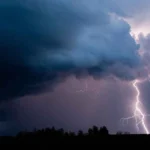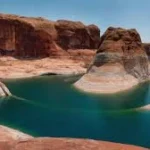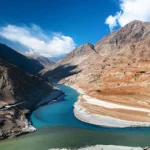
Floods are a common and destructive natural disaster that can affect people and communities around the world. They occur when a body of water, such as a river or stream, overflows its banks and spills onto the surrounding land. Floods can cause damage to homes, businesses, and infrastructure, and they can also pose a serious threat to human life.
There are many interesting and surprising facts about specific flood events and phenomena that are worth knowing. Here are 15 examples:
1.The largest flood in recorded history occurred in China in 1931, when the Yellow River overflowed its banks and affected an estimated 145 million people.
2. The highest recorded flood in the world occurred in the Andes Mountains in 1985, when a glacial lake in Peru burst and released 20 billion cubic meters of water, causing a flood wave that reached a height of 120 meters.
3. The longest-lasting flood on record occurred in the United States, when the Mississippi River flooded for a record-breaking 153 days in 1927.
4.In some parts of the world, people have adapted to living with floods by building homes on stilts or floating platforms. For example, in parts of Thailand, people live in houses known as “floating homes” that are built on rafts and can rise and fall with the water levels.
5. Floods can also have positive effects on the environment. For example, floods can help to replenish soil nutrients and support the growth of plants and animals. In some cases, floods can even create new habitats and opportunities for wildlife.
6. The worst flood in the United States occurred in the state of California in 1862, when heavy rainfall caused the Sacramento and San Joaquin rivers to overflow, affecting an estimated 600,000 acres of land.
7. In some cases, floods can be caused by human activities, such as the construction of dams and levees, or the failure to properly manage water resources. For example, in 1996, a flood in the town of Toccoa, Georgia was caused by the failure of a privately-owned dam, resulting in the deaths of 39 people.
8. Some floods are so powerful and destructive that they are known as “megafloods.” For example, the biblical story of Noah’s Ark describes a megaflood that covered the entire Earth, and scientists have also identified evidence of megafloods in the geologic record.
9. In some cases, floods can have a positive impact on human health. For example, some people believe that floods can help to kill disease-carrying insects and reduce the risk of malaria.
10. Floods can also have a significant impact on the economy. For example, the 2013 flood in Alberta, Canada resulted in economic losses estimated at $6 billion, and the 2011 flood in Thailand caused an estimated $45 billion in damages.
11. In some cases, floods can be predicted and even controlled. For example, the Dutch have a long history of flood control, and they have developed sophisticated systems for managing water levels and protecting against floods.
12. Floods can also have a cultural and social impact. For example, the annual flooding of the Nile River in ancient Egypt was considered a sacred and essential event, and it played a central role in the development of Egyptian civilization.
13. In some cases, floods can be caused by natural events that are not related to water, such as earthquakes, volcanic eruptions, and landslides. For example, the 2010 earthquake in Haiti caused a flood when it triggered a landslide that blocked a river and caused the water to overflow.
14. Some floods are so large and widespread that they can be seen from space. For example, in 2016, the NASA Earth Observatory published satellite images of the Great Flood of 2016, which affected parts of China, India, Nepal, and Bangladesh.
15. In some cases, floods can have a lasting impact on people and communities, even long after the flood waters have receded. For example, the Great Flood of 1993 in the United States affected more than 40,000 square miles and caused more than $15 billion in damages, and some areas are still recovering from the effects of the flood more than 25 years later.
Floods are a fascinating and complex natural phenomenon that have a significant impact on people and communities around the world. By understanding the facts about specific flood events and phenomena, we can gain a deeper understanding of these events and their effects, and we can better prepare for and respond to future floods. Whether we are dealing with the largest and most destructive floods, or the more manageable and even beneficial floods, it is important to have a deep understanding of these events in order to protect ourselves and our communities.
Frequently Asked Questions About Floods:
Floods are natural disasters that can cause significant damage to property and infrastructure. Here are some common questions people have about floods, along with detailed answers:
1. What causes floods?
Floods can be caused by various factors, including:
- Heavy rainfall: Excessive precipitation over a short period can overwhelm rivers and drainage systems, causing them to overflow their banks.
- Rapid snowmelt: When large amounts of snow melt quickly due to warm temperatures, it can lead to flooding, especially if the ground is already saturated.
- Storm surges: Coastal areas are particularly susceptible to flooding caused by storm surges, which are abnormal rises in sea level due to high winds and low atmospheric pressure associated with storms.
- Dam failures: If a dam breaks or malfunctions, it can release a large volume of water unexpectedly, causing catastrophic flooding downstream.
- Coastal erosion: Rising sea levels and erosion can weaken natural coastal defenses, making areas more prone to flooding during storms or high tides.
2. What are the different types of floods?
There are several ways to categorize floods:
- Riverine floods: These are the most common type of flood, occurring when rivers overflow their banks due to heavy rain, rapid snowmelt, or dam failures.
- Coastal floods: These floods occur along coastlines due to storm surges caused by hurricanes, cyclones, or other strong coastal storms.
- Flash floods: These are sudden and violent floods that occur with little warning, typically in areas with steep slopes or low-lying terrain following heavy rainfall.
- Urban floods: Poor drainage systems and extensive impervious surfaces (like pavement) in urban areas can lead to rapid flooding during heavy rain.
3. How can I find out if I am at risk of flooding?
Several resources can help you determine your flood risk:
- Flood maps: Many government agencies provide online flood maps that indicate areas with different flood risks. Search for “[your country] flood map” to find the specific agency responsible.
- Community alerts: Sign up for local emergency alerts to receive notifications about potential flooding events.
- Elevation: Knowing your property’s elevation relative to nearby waterways can help assess your flood risk.
4. What should I do to prepare for a flood?
Here are some steps you can take to prepare for a flood:
- Develop a flood plan: Discuss with your family a plan for evacuation routes, communication methods, and meeting places in case of a flood.
- Assemble an emergency kit: Include essentials like non-perishable food, bottled water, first-aid supplies, medications, flashlights, batteries, and a radio.
- Floodproof your property: Measures like raising electrical components, installing flood barriers, and waterproofing basements can help minimize flood damage.
- Important documents: Keep essential documents like insurance policies, identification cards, and financial records in a waterproof container.
5. What should I do during a flood?
If a flood is imminent or already happening, take these steps:
- Evacuate if necessary: Follow instructions from local authorities and evacuate if your area is under a flood warning.
- Turn off utilities: If it’s safe to do so, turn off electricity and gas at the main switch to prevent electrical hazards and fire risks.
- Stay off flooded roads: Do not attempt to drive through floodwaters. Even a small amount of moving water can be powerful enough to sweep away a vehicle.
- Go to higher ground: Move to higher ground if your home is starting to flood.
6. What should I do after a flood?
Here’s how to recover after a flood:
- Wait for authorities: Do not re-enter your home until authorities declare it safe.
- Assess the damage: Once it’s safe, inspect your home for structural damage, electrical hazards, and water contamination.
- Document the damage: Take photos and videos of the damage for insurance purposes.
- Contact your insurance company: File a claim with your insurance company to cover repairs and replacements.
- Beware of mold: Flooding can lead to mold growth. Be aware of potential health risks and take steps to remove mold if necessary.
By understanding flood risks and taking proper precautions, you can minimize the impact of these events and keep yourself and your family safe.








